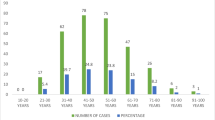Summary
A retrospective study was performed to explore the relationship between molecular subtypes and clinicopathological features of breast cancer in Chinese women. Six hundred and twenty-eight Chinese women with breast cancer were classified into four molecular subtypes according to their estrogen receptor (ER), progesterone receptor (PR) and Her-2 status. The prevalence rate of each molecular subtype was analyzed. Relationship between the subtypes and clinicopathologic features was determined. The distribution of molecular subtypes was as follows: luminal A 46.5%, luminal B 17.0%, basal 21.5%, HER2/neu 15.0%. The subtypes had no significant difference under different menopausal status. However, in the age-specific groups, the age group of ≤35 years was more likely to get basal cell-like cancer (36.9%). Statistically significant differences were found among molecular subtypes by age, nuclear grade, tumor size, lymph node (LN) metastasis, tumor stage by American Joint Committee on Cancer (AJCC), radiotherapy but not by chemotherapy, types of surgery. After adjusting for several relative confounding factors, the basal subtype more likely had lower nodal involvement in both the incidence of LN metastasis (≥1 positive LN) and incidence of high-volume LN metastasis (≥4 positive LN). The HER2/neu subtype had higher nodal involvement in the incidence of high-volume LN metastases. After adjusting for relative confounding factors, the HER2/neu subtype more likely had higher AJCC tumor stages. It was suggested that there existed close relationship between molecular subtypes and clinicopathological features of breast cancer. In addition, the breast cancer subtypes have been proven to be an independent predictor of LN involvement and AJCC tumor stage. These findings are very important for understanding the occurrence, development, prognosis and treatment of breast cancer in Chinese population.
Similar content being viewed by others
References
Greenlee RT, Murray T, Bolden S, et al. Cancer statistics, 2000. CA Cancer J Clin, 2000,50(1):7–33
Tavassoli FA, Schnitt SJ. Pathology of the breast. New York: Elsevier, 1992:27–36
Wiencke JK. Opinion: Impact of race/ethnicity on molecular pathways in human cancer. Nat Rev Cancer, 2004,4(1):79–84
Sorlie T, Tibshirani R, Parker J, et al. Repeated observation of breast tumor subtypes in independent gene expression data sets. Proc Natl Acad Sci USA, 2003,100(14):8418–8423
Brenton JD, Carey LA, Ahmed AA, et al. Molecular classification and molecular forecasting of breast cancer: ready for clinical application? J Clin Oncol, 2005,23(29): 7350–7360
Nguyen PL, Taghian AG, Katz MS, et al. Breast cancer subtype approximated by estrogen receptor, progesterone receptor, and HER-2 is associated with local and distant recurrence after breast conserving therapy. J Clin Oncol, 2008,26(14):2373–2378
Rouzier R, Perou CM, Symmans WF, et al. Breast cancer molecular subtypes respond differently to preoperative chemotherapy. Clin Cancer Res, 2005,11(16): 5678–5685
Voduc KD, Cheang MCU, Tyldesley S, et al. Breast cancer subtypes and the risk of local and regional relapse. J Clin Oncol, 2010,28(10):1684–1691
Perou CM, Sorlie T, Eisen MB, et al. Molecular portraits of human breast tumors. Nature, 2000,406(6797):747–752
Sorlie T, Perou CM, Tibshirani R, et al. Gene expression patterns of breast carcinomas distinguish tumor subclasses with clinical implications. Proc Natl Acad Sci USA, 2001,98(19):10 869–10 874
Wiecmann L, Sampson M, Stempel M, et al. Presenting features of breast cancer differ by molecular subtype. Ann Surg Oncol, 2009,16(10):2705–2710
Blackman DJ, Masi CM. Racial and ethnic disparities in breast cancer mortality: Are we doing enough to address the root causes? J Clin Oncol, 2006,24(14):2170–2178
Crabb SJ, Cheang MC, Leung S, et al. Basal breast cancer molecular subtype predicts for lower incidence of axillary lymph node metastases in primary breast cancer. Clin Breast Cancer, 2008,8(3):249–256
Rakha EA, El-Sayed ME, Green AR, et al. Prognostic markers in triple-negative breast cancer. Cancer, 2007, 109(1):25–32
Haffty BG, Yang Q, Reiss M, et al. Locoregional relapse and distant metastasis in conservatively managed triple negative early-stage breast cancer. J Clin Oncol, 2006,24(36):5652–5657
Kim MJ, Ro JY, Ahn SH, et al. Clinicopathologic significance of the basal-like subtype of breast cancer: A comparison with hormone receptor and Her2/neu-over-expressing phenotypes. Hum Pathol, 2006,37(9):1217–1226
Kurebayashi J, Moriya T, Ishida T, et al. The prevalence of intrinsic subtypes and prognosis in breast cancer patients of different races. Breast, 2007,16(suppl 2):s72–77
Ihemelandu CU, Leffall LD Jr, Dewitty RL, et al. Molecular breast cancer subtypes in premenopausal and postmenopausal African-American women: age-specific prevalence and survival. J Surg Res, 2007,143(1): 109–118
Chlebowski RT, Chen Z, Anderson GL, et al. Ethnicity and breast cancer: Factors influencing differences in incidence and outcome. J Natl Cancer Inst, 2005,97(6): 439–448
Nielsen TO, Hsu FD, Jensen K, et al. Immunohistochemical and clinical characterization of the basal-like subtype of invasive breast carcinoma. Clin Cancer Res, 2004,10(16):5367–5374
Carey LA, Perou CM, Livasy CA, et al. Race, breast cancer subtypes, and survival in the carolina breast cancer study. JAMA, 2006,295(21):2492–2502
Rakha EA, El-Rehim DA, Paish C, et al. Basal phenotype identifies a poor prognostic subgroup of breast cancer of clinical importance. Eur J Cancer, 2006,42(18):3149–3156
Author information
Authors and Affiliations
Corresponding author
Rights and permissions
About this article
Cite this article
Cheng, Ht., Huang, T., Wang, W. et al. Clinicopathological features of breast cancer with different molecular subtypes in chinese women. J. Huazhong Univ. Sci. Technol. [Med. Sci.] 33, 117–121 (2013). https://doi.org/10.1007/s11596-013-1082-2
Received:
Published:
Issue Date:
DOI: https://doi.org/10.1007/s11596-013-1082-2




